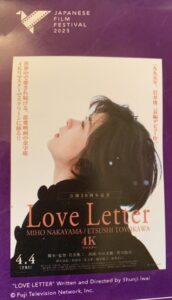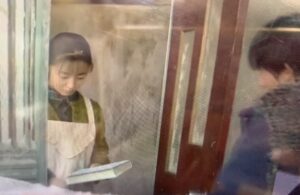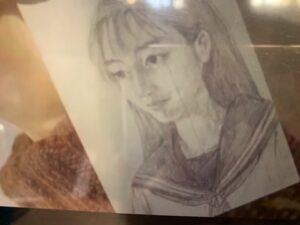“Love Letter” opens the SM Baguio Japanese Film Festival 2025
By: Nonnette C. Bennett, photos taken from Bilibili and Google
I am an avid fan of Japanese movies because there is something different about the Japanese scriptwriter or author who gives you the unexpected as a twist to a movie. There is nothing predictable about the ending of their movies. So it was the same with “Love Letter” a romance drama that is 30 years old starring Nakayama Miho and directed by Iwai Shunji.
This was the opening movie for the film festival that just launched at SM Cinema and the 13 films will run until 5 October with four screening times daily. All the movies are free.
Director and writer Iwai Shunji at the beginning of the movie said that Nakayama Miho, the actress, 54, died on 6 December 2024. The film that was shown in 1995 was restored to 4K resolution as evidence to Japanese technology in film.
Itsuki receives the book that Itsuki wants her to return to the library.
Love Letter is a truly a timeless masterpiece of romance that people of all ages can relate to. Miho, then 24, is a typical marriageable female ready to settle down. However, her fiancé dies.
The movie shows the Japanese tradition of celebrating the second anniversary of death to end the period of mourning. This is attended by Hiroko Watanabe (Miho) with friends of her fiancé, Itsuki Fujii (Takashi Kashiwabara). She wanted to find out more about her fiancé in order to finally let go of the memories. She was shown a yearbook from the school of Itsuki and she decided to write him a letter in the address stated even if the house he lived in was said to have been replaced by a highway.
The sketch of Itsuki by Itsuki in the back of the library card is given by the student assistants at the library.
She is surprised to receive a letter from Itsuki Fujii, only to find out later that this was a girl who had the same name as her fiancé and was a classmate in high school for three years. Hiroko is curious about Itsuki and goes to Otaru. When their eyes meet, they actually look alike.
Hiroko asks Itsuki to give her photographs and details of the school that they attended. The correspondence goes on with details of how Itsuki, the male, was quiet and not so bright as a student. How Itsuki, the girl, had to bear the burden of being his class partner in tasks where he hardly helped. The library is the most memorable place at school where the two Itsukis were assigned as assistants. It was here where Itsuki, the boy, spent his time looking for books never borrowed to write his name in the library cards.
Itsuki, when she visited the school to take the photos requested by Hiroko, went to the library and met a group of young girls who were assigned there. When she said her name, the girls screeched with excitement when they told her that they counted 87 books total with her name written on it. She apologized and said that it wasn’t her but a boy of the same name.
As Hiroko gets a marriage proposal from Akiba Shigeru (Etsushi Toyokawa), one of the best friends of her fiancé Itsuki, they agree to visit the mountain where he died and ask for his permission.
Itsuki, the girl, is visited by the group of high school girls to show her the last book that they found with her name. The book was what Itsuki, the boy, gave her to return to the library before he transferred to another school in senior high. In the back of the card, he had sketched her.
Itsuki decides not to write to Hiroko about the drawing.
The use of the teen age in the film also talks about the culture. This is an insight into how the youth handle love.
The film is beautifully set in snowy Japan, and the crisp and fine cinematography show how Japanese technology is able to preserve films for literature, art, and culture. The Japanese cultural education through cinema is a subtle way of bridging understanding across the nations of the world.





